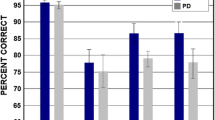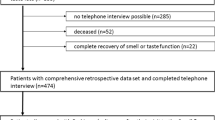Abstract
It is well known that Parkinson’s disease is characterized by a variety of non-motor symptoms. A gustatory deficit is hypothesized to be one of them although few and only cross-sectional studies are available. The aim of our pilot study was to prospectively investigate the taste function in Parkinson’s disease patients after some years from the first evaluation (mean follow-up 4.35 ± 0.49 years; time range 3.5–5.6 years). A group of 26 patients was re-examined (16 males and 10 females; mean age 70.9 ± 8.4 years, range 54–88 years). Taste function was assessed in one session, by means of the Whole Mouth Test (WMT) and Taste Strips Test (TST). Olfaction was also evaluated with the Sniffin’ Sticks Identification Test (SST). All these tests are commercially available (Burghart Company, Germany). All patients were able to understand and complete the procedure. Although scores decreased over time, no significant difference was found between global taste scores of first and second evaluation, neither comparing every single taste quality (WMT: p = 0.234, Mann–Whitney U test; TST: p = 0.747, Mann–Whitney U test; McNemar chi-square in the range of 0–1.455). These results confirm a persistent but slight and stable taste impairment, in patients with Parkinson’s disease. Future studies on a much larger sample of patients are certainly required.

Similar content being viewed by others
References
Ahne G, Erras A, Hummel T, Kobal G (2000) Assessment of gustatory function by means of tasting tablets. Laryngoscope 110:1396–1401
Braak H, Del Tredici K, Bratzke H, Hamm-Clement J, Sandmann-Keil D, Rub U (2002) Staging of the intracerebral inclusion body pathology associated with idiopathic Parkinson’s disease (preclinical and clinical stages). J Neurol 249:1–5
Cecchini MP, Osculati F, Ottaviani S, Boschi F, Fasano A, Tinazzi M (2014) Taste performance in Parkinson’s disease. J Neural Transm 121:119–122
Cecchini MP, Fasano A, Boschi F, Osculati F, Tinazzi M (2015) Taste in Parkinson’s disease. J Neurol 262:806–813
Deeb J, Shah M, Muhammed N et al (2010) A basic smell test is a sensitive as dopamine transporter scan: comparison of olfaction, taste and DaTSCAN in the diagnosis of Parkinson’s disease. QJMed 103:941–952
Deems DA, Doty RL, Settle RG, Moore-Gillon V, Shaman P, Mester AF, Kimmelman CP, Brightman VJ, Snow JB Jr (1991) Smell and taste disorders, a study of 750 patients from the University of Pennsylvania Smell and Taste Center. Arch Otolaryngol Head Neck Surg 117:519–528
Doty RL, Nsoesie MT, Chung I, Osman A, Pawasarat I, Caulfield J, Hurtig H, Silas J, Dubroff J, Duda JE, Ying JS, Tekeli H, Leon-Sarmiento FE (2015) Taste function in early stage treated and untreated Parkinson’s disease. J Neurol 262:547–557
Gilmore MM, Green BG (1993) Sensory irritation and taste produced by NaCl and citric acid: effects of capsaicin desensitization. Chem Senses 18:257–272
Goetz CG, Poewe W, Rascol O, Sampaio C, Stebbins GT, Counsell C, Giladi N, Holloway R, Moore CG, Wenning GK, Yahr MD, Seidl L (2004) Movement disorder society task force report on the Hoehn and Yahr staging scale: status and recommendations. Mov Disord 19:1020–1028
Haehner A, Hummel T, Reichmann H (2014) A clinical approach towards smell loss in Parkinson’s disease. J Parkinsons Dis 4:189–195
Hummel T, Kobal G, Gudziol H, Mackay-Sim A (2007) Normative data for the “Sniffin’ Sticks” including tests of odor identification, odor discrimination, and olfactory thresholds: an upgrade based on a group of more than 3000 subjects. Eur Arch Otorhinolaryngol 264:237–243
Kashihara K, Hanaoka A, Imamura T (2011) Frequency and characteristics of taste impairment in patients with Parkinson’s disease: results of a clinical interview. Intern Med 50:2311–2315
Kim H-J, Jeon BS, Lee J-Y et al (2011) Taste function in patients with Parkinson’s disease. J Neurol 258:1076–1079
Landis BN, Welge-Luessen A, Brämerson A, Bende M, Mueller CA, Nordin S, Hummel T (2009) “Taste Strips”—a rapid, lateralized, gustatory bedside identification test based on impregnated filter papers. J Neurol 256:242–248
Landis BN, Scheibe M, Weber C, Berger R, Brämerson A, Bende M, Nordin S, Hummel T (2010) Chemosensory interaction: acquired olfactory impairment is associated with decreased taste function. J Neurol 257:1303–1308
Lang CJG, Leuschner T, Ulrich K et al (2006) Taste in dementing diseases and parkinsonism. J Neurol Sci 248:177–184
Moberg PJ, Balderston CC, Rick JH, Roalf DR, Weintraub D, Kleiner-Fisman G, Stern MB, Duda JE (2007) Phenylthiocarbamide (PTC) perception in Parkinson disease. Cogn Behav Neurol 20:145–148
Mueller C, Kallert S, Renner B, Stiassny K, Temmel AF, Hummel T, Kobal G (2003) Quantitative assessment of gustatory function in a clinical context using impregnated “taste strips”. Rhinology 41:2–6
Shah M, Deeb J, Fernando M et al (2009) Abnormality of taste and smell in Parkinson’s disease. Parkinsonism Relat Disord 15:232–237
Sienkiewicz-Jarosz H, Scinska A, Kuran W et al (2005) Taste responses in patients with Parkinson’s disease. J Neurol Neurosurg Psychiatry 76:40–46
Sienkiewicz-Jarosz H, Scinska A, Swiecicki L, Lipczynska-Lojkowska W, Kuran W, Ryglewicz D, Kolaczkowski M, Samochowiec J, Bienkowski P (2013) Sweet liking in patients with Parkinson’s disease. J Neurol Sci 329:17–22
Acknowledgements
We gratefully acknowledge the participants in this trial, as well as their family members and caregivers.
Author information
Authors and Affiliations
Corresponding author
Ethics declarations
Conflict of interest
The authors declare that they have no conflict of interest.
Rights and permissions
About this article
Cite this article
Ricatti, M.J., Ottaviani, S., Boschi, F. et al. A prospective evaluation of taste in Parkinson’s disease. J Neural Transm 124, 347–352 (2017). https://doi.org/10.1007/s00702-016-1638-y
Received:
Accepted:
Published:
Issue Date:
DOI: https://doi.org/10.1007/s00702-016-1638-y




